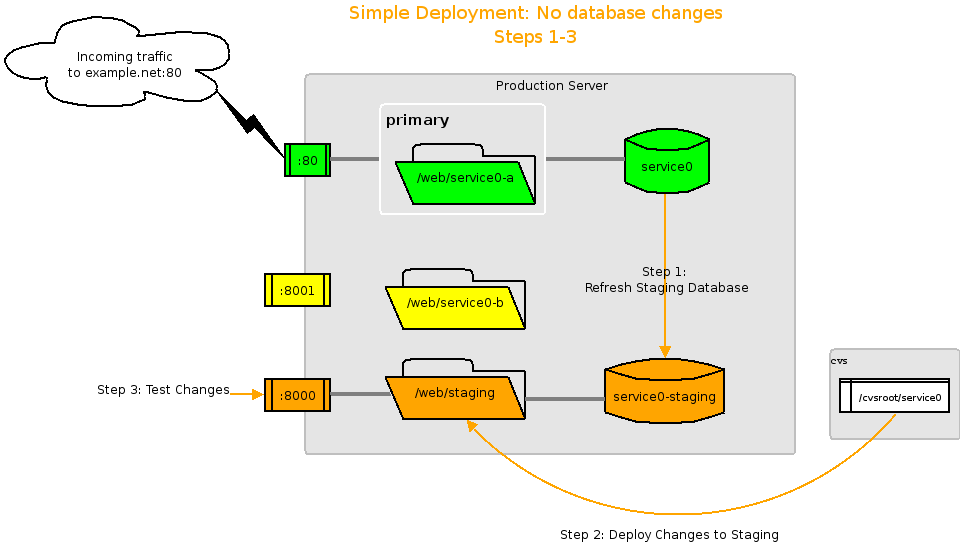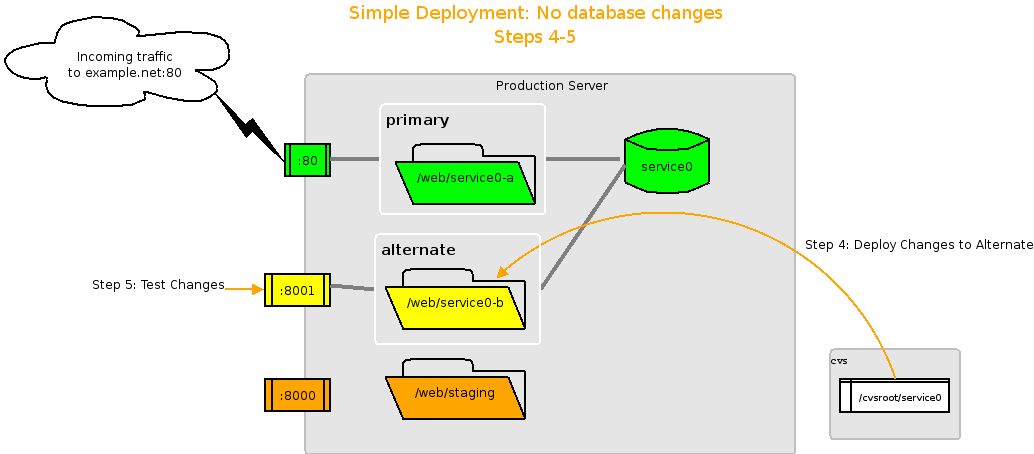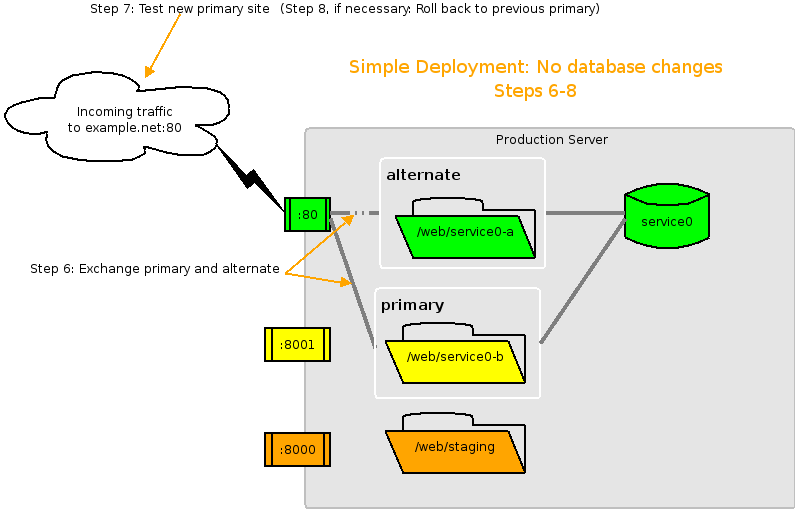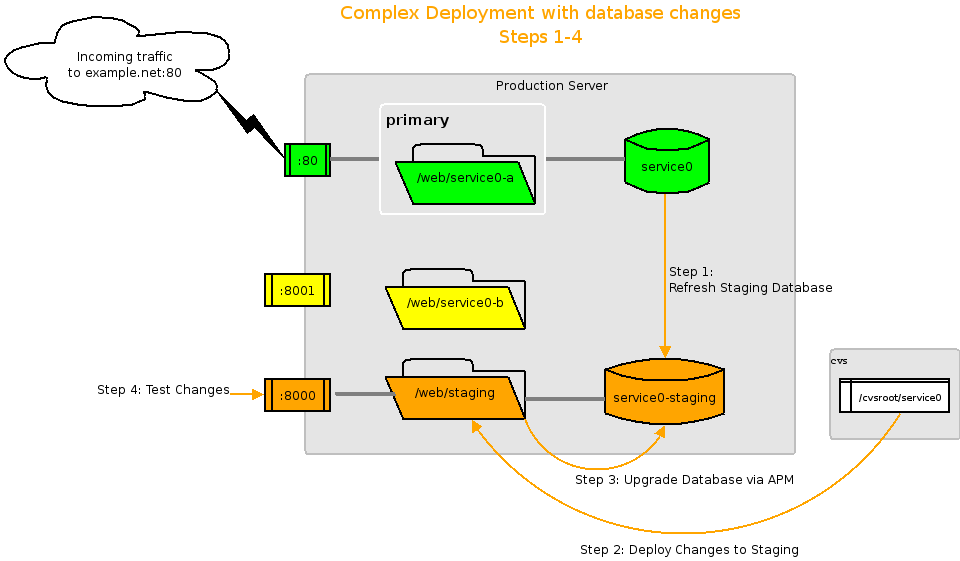- I OpenACS For Everyone
- I.1 High level information: What is OpenACS?
- I.1.1 Overview
- I.1.2 OpenACS Release Notes
- I.2 OpenACS: robust web development framework
- I.2.1 Introduction
- I.2.2 Basic infrastructure
- I.2.3 Advanced infrastructure
- I.2.4 Domain level tools
- I.1 High level information: What is OpenACS?
- II Administrator's Guide
- II.2 Installation Overview
- II.2.1 Basic Steps
- II.2.2 Prerequisite Software
- II.3 Complete Installation
- II.3.1 Install a Unix-like system and supporting software
- II.3.2 Install Oracle 10g XE on debian
- II.3.2.1 Install Oracle 8.1.7
- II.3.3 Install PostgreSQL
- II.3.4 Install AOLserver 4
- II.3.5 Quick Install of OpenACS
- II.3.5.1 Complex Install OpenACS 5.3
- II.3.6 OpenACS Installation Guide for Windows2000
- II.3.7 OpenACS Installation Guide for Mac OS X
- II.4 Configuring a new OpenACS Site
- II.4.1 Installing OpenACS packages
- II.4.2 Mounting OpenACS packages
- II.4.3 Configuring an OpenACS package
- II.4.4 Setting Permissions on an OpenACS package
- II.4.5 How Do I?
- II.4.6 Configure OpenACS look and feel with templates
- II.5 Upgrading
- II.5.1 Overview
- II.5.2 Upgrading 4.5 or higher to 4.6.3
- II.5.3 Upgrading OpenACS 4.6.3 to 5.0
- II.5.4 Upgrading an OpenACS 5.0.0 or greater installation
- II.5.5 Upgrading the OpenACS files
- II.5.6 Upgrading Platform components
- II.6 Production Environments
- II.6.1 Starting and Stopping an OpenACS instance.
- II.6.2 AOLserver keepalive with inittab
- II.6.3 Running multiple services on one machine
- II.6.4 High Availability/High Performance Configurations
- II.6.5 Staged Deployment for Production Networks
- II.6.6 Installing SSL Support for an OpenACS service
- II.6.7 Set up Log Analysis Reports
- II.6.8 External uptime validation
- II.6.9 Diagnosing Performance Problems
- II.7 Database Management
- II.7.1 Running a PostgreSQL database on another server
- II.7.2 Deleting a tablespace
- II.7.3 Vacuum Postgres nightly
- II.8 Backup and Recovery
- II.8.1 Backup Strategy
- II.8.2 Manual backup and recovery
- II.8.3 Automated Backup
- II.8.4 Using CVS for backup-recovery
- II.A Install Red Hat 8/9
- II.B Install additional supporting software
- II.B.1 Unpack the OpenACS tarball
- II.B.2 Initialize CVS (OPTIONAL)
- II.B.3 Add PSGML commands to emacs init file (OPTIONAL)
- II.B.4 Install Daemontools (OPTIONAL)
- II.B.5 Install qmail (OPTIONAL)
- II.B.6 Install Analog web file analyzer
- II.B.7 Install nspam
- II.B.8 Install Full Text Search
- II.B.9 Install Full Text Search using Tsearch2
- II.B.10 Install Full Text Search using OpenFTS (deprecated see tsearch2)
- II.B.11 Install nsopenssl
- II.B.12 Install tclwebtest.
- II.B.13 Install PHP for use in AOLserver
- II.B.14 Install Squirrelmail for use as a webmail system for OpenACS
- II.B.15 Install PAM Radius for use as external authentication
- II.B.16 Install LDAP for use as external authentication
- II.B.17 Install AOLserver 3.3oacs1
- II.C Credits
- II.C.1 Where did this document come from?
- II.C.2 Linux Install Guides
- II.C.3 Security Information
- II.C.4 Resources
- II.2 Installation Overview
- III For OpenACS Package Developers
- III.9 Development Tutorial
- III.9.1 Creating an Application Package
- III.9.2 Setting Up Database Objects
- III.9.3 Creating Web Pages
- III.9.4 Debugging and Automated Testing
- III.10 Advanced Topics
- III.10.1 Write the Requirements and Design Specs
- III.10.2 Add the new package to CVS
- III.10.3 OpenACS Edit This Page Templates
- III.10.4 Adding Comments
- III.10.5 Admin Pages
- III.10.6 Categories
- III.10.7 Profile your code
- III.10.8 Prepare the package for distribution.
- III.10.9 Distributing upgrades of your package
- III.10.10 Notifications
- III.10.11 Hierarchical data
- III.10.12 Using .vuh files for pretty urls
- III.10.13 Laying out a page with CSS instead of tables
- III.10.14 Sending HTML email from your application
- III.10.15 Basic Caching
- III.10.16 Scheduled Procedures
- III.10.17 Enabling WYSIWYG
- III.10.18 Adding in parameters for your package
- III.10.19 Writing upgrade scripts
- III.10.20 Connect to a second database
- III.10.21 Future Topics
- III.11 Development Reference
- III.11.1 OpenACS Packages
- III.11.2 OpenACS Data Models and the Object System
- III.11.3 The Request Processor
- III.11.4 The OpenACS Database Access API
- III.11.5 Using Templates in OpenACS
- III.11.6 Groups, Context, Permissions
- III.11.7 Writing OpenACS Application Pages
- III.11.8 Parties in OpenACS
- III.11.9 OpenACS Permissions Tediously Explained
- III.11.10 Object Identity
- III.11.11 Programming with AOLserver
- III.11.12 Using Form Builder: building html forms dynamically
- III.12 Engineering Standards
- III.12.1 OpenACS Style Guide
- III.12.2 Release Version Numbering
- III.12.3 Constraint naming standard
- III.12.4 ACS File Naming and Formatting Standards
- III.12.5 PL/SQL Standards
- III.12.6 Variables
- III.12.7 Automated Testing
- III.13 CVS Guidelines
- III.13.1 Using CVS with OpenACS
- III.13.2 OpenACS CVS Concepts
- III.13.3 Contributing code back to OpenACS
- III.13.4 Additional Resources for CVS
- III.14 Documentation Standards
- III.14.1 OpenACS Documentation Guide
- III.14.2 Using PSGML mode in Emacs
- III.14.3 Using nXML mode in Emacs
- III.14.4 Detailed Design Documentation Template
- III.14.5 System/Application Requirements Template
- III.15 TCLWebtest
- III.16 Internationalization
- III.16.1 Internationalization and Localization Overview
- III.16.2 How Internationalization/Localization works in OpenACS
- III.16.4 Design Notes
- III.16.5 Translator's Guide
- III.D Using CVS with an OpenACS Site
- III.9 Development Tutorial
- IV For OpenACS Platform Developers
- IV.17 Kernel Documentation
- IV.17.1 Overview
- IV.17.2 Object Model Requirements
- IV.17.3 Object Model Design
- IV.17.4 Permissions Requirements
- IV.17.5 Permissions Design
- IV.17.6 Groups Requirements
- IV.17.7 Groups Design
- IV.17.8 Subsites Requirements
- IV.17.9 Subsites Design Document
- IV.17.10 Package Manager Requirements
- IV.17.11 Package Manager Design
- IV.17.12 Database Access API
- IV.17.13 OpenACS Internationalization Requirements
- IV.17.14 Security Requirements
- IV.17.15 Security Design
- IV.17.16 Security Notes
- IV.17.17 Request Processor Requirements
- IV.17.18 Request Processor Design
- IV.17.19 Documenting Tcl Files: Page Contracts and Libraries
- IV.17.20 Bootstrapping OpenACS
- IV.17.21 External Authentication Requirements
- IV.18 Releasing OpenACS
- IV.18.1 OpenACS Core and .LRN
- IV.18.2 How to Update the OpenACS.org repository
- IV.18.3 How to package and release an OpenACS Package
- IV.18.4 How to Update the translations
- IV.17 Kernel Documentation
- V Tcl for Web Nerds
- V.1 Tcl for Web Nerds Introduction
- V.2 Basic String Operations
- V.3 List Operations
- V.4 Pattern matching
- V.5 Array Operations
- V.6 Numbers
- V.7 Control Structure
- V.8 Scope, Upvar and Uplevel
- V.9 File Operations
- V.10 Eval
- V.11 Exec
- V.12 Tcl for Web Use
- V.13 OpenACS conventions for TCL
- V.14 Solutions
- VI SQL for Web Nerds
- VI.1 SQL Tutorial
- VI.1.1 SQL Tutorial
- VI.1.2 Answers
- VI.2 SQL for Web Nerds Introduction
- VI.3 Data modeling
- VI.3.1 The Discussion Forum -- philg's personal odyssey
- VI.3.2 Data Types (Oracle)
- VI.3.4 Tables
- VI.3.5 Constraints
- VI.4 Simple queries
- VI.5 More complex queries
- VI.6 Transactions
- VI.7 Triggers
- VI.8 Views
- VI.9 Style
- VI.10 Escaping to the procedural world
- VI.11 Trees
- VI.1 SQL Tutorial
II.6.5 Staged Deployment for Production Networks
This section describes two minimal-risk methods for deploying changes on a production network. The important characteristics of a safe change deployment include: (THIS SECTION IN DEVELOPMENT)
-
Control: You know for sure that the change you are making is the change that you intend to make and is the change that you tested.
-
Rollback: If anything goes wrong, you can return to the previous working configuration safely and quickly.
With this method, we control the files on a site via CVS. This example uses one developmental server (service0-dev) and one production server (service0). Depending on your needs, you can also have a staging server for extensive testing before you go live. The only way files should move between the server instances is via cvs.
To set up a developmental installation, first set up either your developmental installation or your production installation, and follow the instructions for committing your files to CVS. We'll assume in this example that you set up the production server (service0). To set up the developmental instance, you then follow the intall guide again, this time creating a new user (service0-dev) that you'll use for the new installation. To get the files for service0-dev, you check them out from cvs (check out service0).
su - service0-dev co -d /cvsroot service0 mv service0 /var/lib/aolserver/service0-dev ln -s /home/service0-dev/web /var/lib/aolserver/service0-dev emacs web/etc/config.tcl emacs web/etc/daemontools/run
In the config.tcl file, you'll probably want to pay attention the rollout support section. That will ensure that email on your developmental server will not be sent out to the general world.
Also, instead of going through the OpenACS online installer, you'll actually load live data into your production server.
You can even automate the process of getting live data from your production server. Copy something like this to /home/service0-dev/bin and put it in service0-dev's crontab to run once a night. You'll need to make sure the database backups are set up in service0's crontab, and that if the servers are on different physical machines, that the database backup is copied to the developmental machine once per night.
/usr/local/bin/svc -d /service/service0-dev /bin/sleep 60 # this deletes the dev database! /usr/local/pgsql/bin/dropdb service0-dev /usr/local/pgsql/bin/createdb -E UNICODE service0-dev # this is not necessary from Postgres 7.4 on /usr/local/pgsql/bin/psql -f /var/lib/aolserver/service0-dev/packages/acs-kernel/sql/postgresql/postgresql.sql service0 mv /var/lib/aolserver/service0/database-backup/service0-nightly-backup.dmp.gz /var/lib/aolserver/service0-dev/database-backup/service0-nightly-backup-old.dmp.gz /bin/gunzip /var/lib/aolserver/service0-dev/database-backup/service0-nightly-backup.dmp.gz /usr/bin/perl -pi -e "s/^\\connect service0$/\\connect service0-dev/" /var/lib/aolserver/service0-dev/database-backup/service0-nightly-backup.dmp /usr/local/pgsql/bin/psql service0-dev < /var/lib/aolserver/service0-dev/database-backup/service0-nightly-backup.dmp /usr/local/bin/svc -u /service/service0-dev /bin/gzip /var/lib/aolserver/service0-dev/database-backup/service0-nightly-backup-old.dmp
Your developmental server will always have data about a day old.
To make changes on service0-dev:
1) change the file on service0-dev as desired 2) test the new file 3) commit the file: if the file is /var/lib/aolserver/service0-dev/www/index.adp, do: cd /var/lib/aolserver/service0-dev/www cvs diff index.adp (this is optional; it's just a reality check) the lines starting > will be added and the lines starting < will be removed, when you commit if that looks okay, commit with: cvs -m "changing text on front page for February conference" index.adp the stuff in -m "service0" is a comment visible only from within cvs commands
To make these changes take place on service0:
4) update the file on production: cd /var/lib/aolserver/service0/www cvs up -Pd index.adp
If you make changes that require changes to the database, test them out first on service0-dev, using either -create.sql or upgrade scripts. Once you've tested them, you then update and run the upgrade scripts from the package manager.
The production site can run "HEAD" from cvs.
The drawback to using HEAD as the live code is that you cannot commit new work on the development server without erasing the definition of 'working production code.' So a better method is to use a tag. This guarantees that, at any time in the future, you can retrieve exactly the same set of code. This is useful for both of the characteristics of safe change deployment. For control, you can use tags to define a body of code, test that code, and then know that what you are deploying is exactly that code. For rollback, you can use return to the last working tag if the new tag (or new, untagged changes) cause problems. .... example of using tags to follow ...
The approach taken in this section is to always create a new service with the desired changes, running in parallel with the existing site. This guarantees control, at least at the final step of the process: you know what changes you are about to make because you can see them directly. It does not, by itself, guarantee the entire control chain. You need additional measures to make sure that the change you are making is exactly and completely the change you intended to make and tested previously, and nothing more. Those additional measures typically take the form of source control tags and system version numbers. The parallel-server approach also guarantees rollback because the original working service is not touched; it is merely set aside.
This approach can has limitations. If the database or file system regularly receiving new data, you must interrupt this function or risk losing data in the shuffle. It also requires extra steps if the database will be affected.






